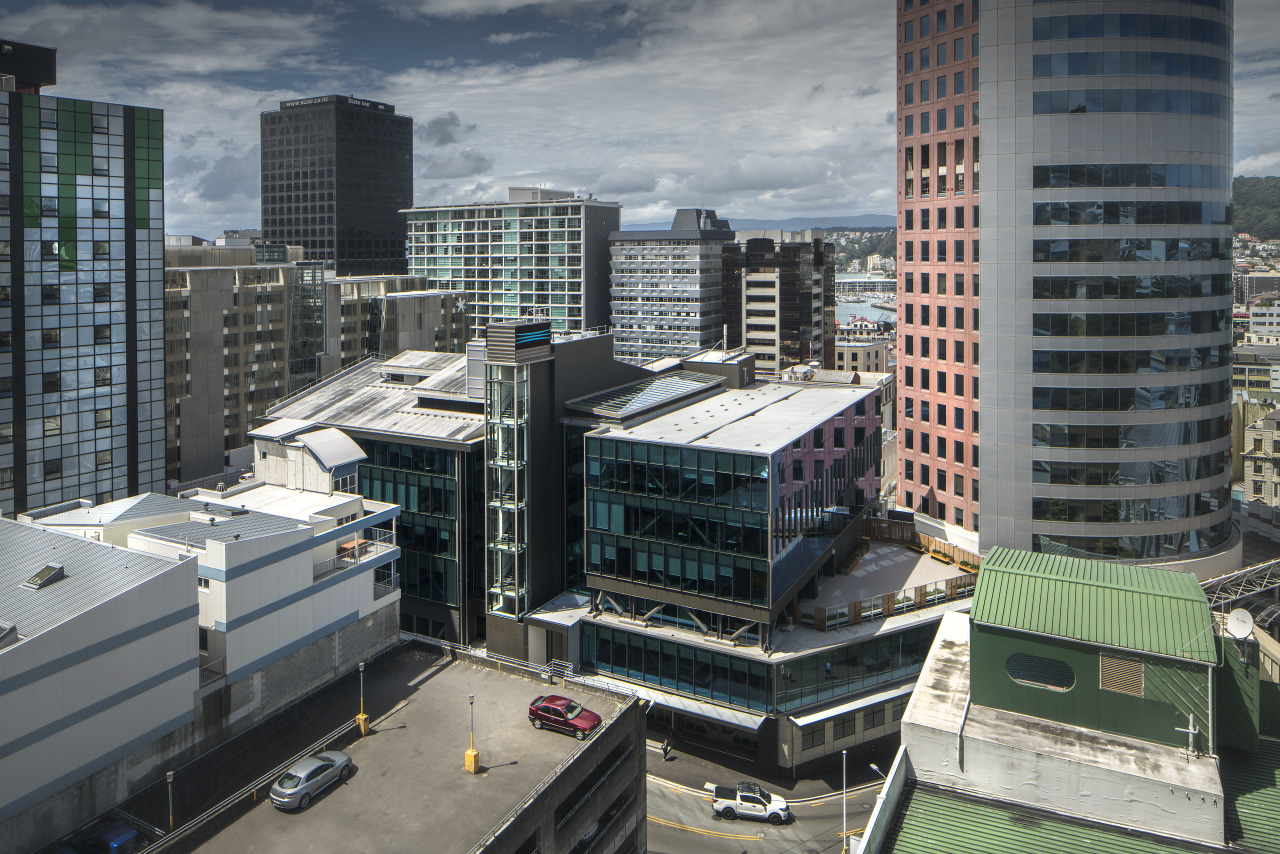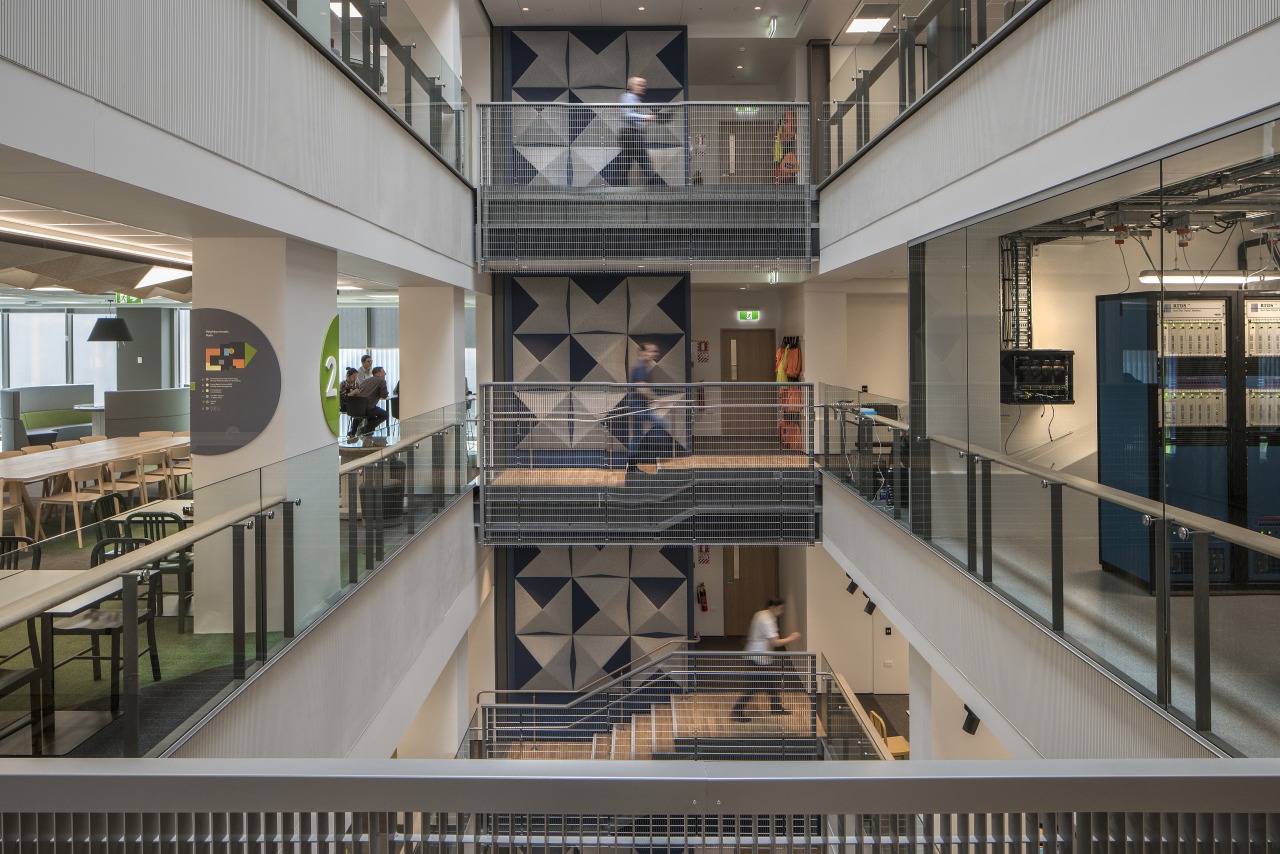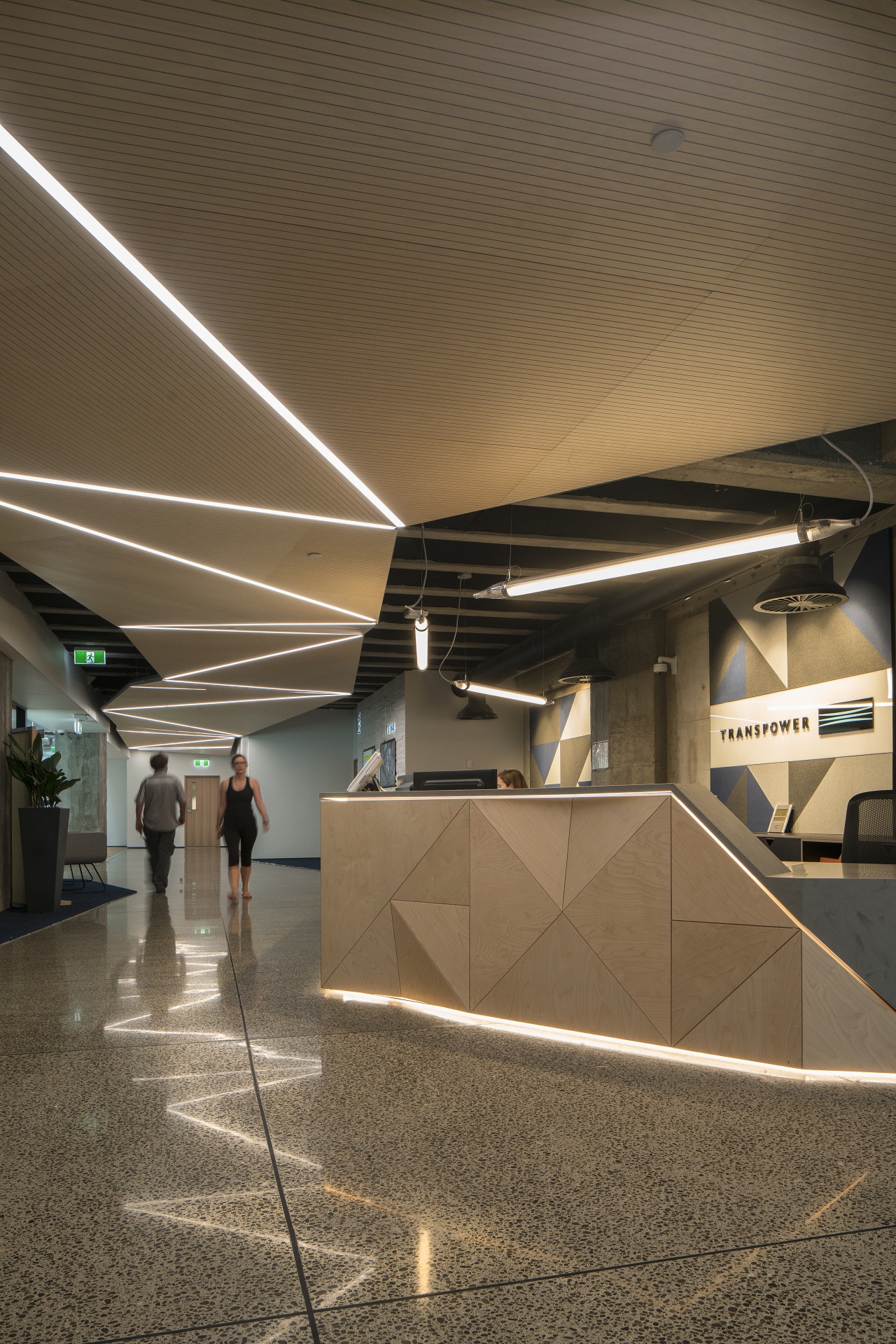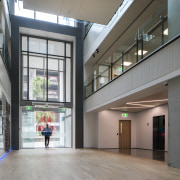Disparate collection of buildings and exterior facades combine into a cohesive whole
Waikoukou – the new home of Transpower – results from the merger of existing buildings, seismically upgraded and linked around a bright new six-level atrium

Brand new, high-functioning office space right inthe heart of Wellington isn’t in ready abundance. However, there’s another, braver, way to achieve the open floorplate, fit-for-purpose modern environment an expanding, go-ahead business might require – appropriate and group buildings already standing.
This was the approach taken for Transpower’s new head office in the capital, says project architect Allan Wright of Architecture +, the firm that designed the complex redevelopment that’s now the contemporary, connected Waikoukou.
“When our client, developer Maurice Clark of Cheops Holdings, acquired the existing buildings they had been vacant for some time,” says Wright.
“Overall, they were of very different design and vintage – the earliest dating back to the 1930s, with the most recent significant works undertaken in the 1980s.
“The interconnected buildings – previously home to the Dom-Post – had been a labyrinthine affair, with poor links between the two existing main north and south buildings. And all these buildings had suffered from neglect. In fact, a significant leap of the imagination was required to see beyond the under-maintained buildings and envisage a contemporary office environment."
The brief was to reorganise, strengthen and open up the cellular buildings and create generous, contiguous, open-office floors focussed around a central atrium space.

“We also had to bring the disparate collection of buildings and exterior facades together into a cohesive whole,” says Wright.
There were several aspects to the programme – beyond the fundamental seismic and structural upgrades of the buildings – required to meet Transpower’s operational requirements. These included stripping out old interior walls, adding three levels to the southern building and creating the glass-roofed atrium, linking stairs and a formal entrance to the inner-city offices.
Then there was the replacement of old exterior frontages and the installation of facades to the new areas with an energy-efficient curtain wall system. This gave the disparate parts of the buildings an harmonious aesthetic, as viewed from the street.
Lastly, tenant car parking has been located in the basement levels of the southern building and in the lower levels of the northern building.
Perhaps the two most dramatic aspects of the project to visitors, however, are the central atrium and double height entry on Boulcott Street.
“The building has a Boulcott Street address and the major entrance is here – at the western end of the atrium,” says the architect.
The double height entry forms a transition between the northern building and the existing two-storey southern building podium, with a stepped pedestrian canopy from the northern end down to the southern edge, on lower Boulcott Street.
A pedestrian link was also developed to allow Transpower staff an easy connection through the refurbished building to a new laneway connection that leads out to Willis Street.
“However, the new atrium with its cross bridges and prominent connecting stairs is figuratively and literally the heart of the scheme, providing a central focus and principal circulation space. The large atrium brings natural light right into the heart of the building on all levels and offers a dynamic space for chance meetings and social interaction.”

Almost all the existing floor plates were retained in the architectural transformation, except for the areas of floor removed to accommodate the atrium. However, a serious amount of demolition of walls was undertaken to open out the floor plates, particularly walls along the north wall of the atrium. Over 3500m³ of concrete and masonry and 250 tonnes of reinforcing steel were removed in all.
Stephen Cummings of McKee Fehl Constructors says sequencing of the structural changes had to be carefully developed to ensure the stability of the buildings wasn’t compromised during the works.
“For example, the creation of the atrium required major and lengthy structural demolition, including the removal of a full shearwall from ground to level 5 that was the main spine of the north building,” says Cummings.
However, this work couldn’t start until a completely new structural system had been installed in key locations. The new structural system was achieved with sprayed concrete shearwalls to the north building, along with installing Buckling Restraint Braces (BRBs) into the existing structure.
“The use of BRBs allowed for the majority of the seismic structure to be located at the edges of the floors, resulting in open, uncluttered office space.”
The BRB is a contemporary seismic device with an outer sheath of steel and an inner steel member set in concrete that functions as a structural damper, yielding and absorbing energy.
“Installing the BRBs into the existing structure was our greatest challenge,” says Cummings. “The connection details through the existing beams and columns required scanning, hammer drilling and then templating for the bracket installation.
“Every connection ended up being different, and there was very little tolerance for installing the final BRB. We also had to contend with the usual inner-city issues of no storage space and limited access.”
Transpower’s interior design was by Jasmax, with Rebecca Burton as interior design lead.
“Jasmax was commissioned to provide workplace strategy and interior design for the project,” says Burton. “We worked closely with Transpower to bring 700 staff from several different sites together in one collaborative, agile, connected environment.”

The fit-out has a semi-industrial feel with aluminium mesh featuring on the central stair, raw concrete floors at ground level, and a pared back choice of finishes generally. This aesthetic worked particularly well in an environment where ceilings, walls, floor and corridors had to be reconciled as the complex build forms were drawn together.
The new reception was one area where Jasmax worked with exposed beams and a confined area to create a feature ceiling with a zigzag lighting feature that acts like a wayfinder in its own right. The geometric feature is one of several touches that play on the idea of looking up through a power pylon and seeing the gridwork as a pattern from below.
This element is also echoed on the faceted front of the reception desk and on the graphic acoustic absorbtion panels on the atrium staircase.
However, it’s the six-level atrium that is the star feature in the interior design, and the fit-out actively encourages activity across and around it.
For example, while the main cafe is on the ground floor, staff kitchens are prominently sited near the stairs on each floor and so are visible from both sides of the atrium. These areas are designed as much for use as casual meeting spaces as they are for preparing and eating lunch.
Colourful, floor-specific signage, furniture and carpet patterning contribute to the energy of the interiors, and these elements can be seen when looking up or down or across the atrium. The colour-coded wayfinders add vibrancy and return a sense of localised space that’s otherwise lost by the comprehensive move to flexible desking.
“Transpower had actually set a target for the new building at 20% flexible and 80% fixed but by the end of the project this had reversed to 80% flexible and 20% fixed,” says Burton. “ On moving in, 90% of staff were using unassigned desking.”
The complexities of working within a number of existing buildings, often armed with only basic documentation of the structures, might sound like anyone’s architectural or logistical nightmare. However, close teamwork between Architecture +, McKee Fehl Constructors and Jasmax resolved these issues to create Waikoukou – a modern, energetic work space for Transpower.
Credit list
Project
Developer
Construction
Electrical engineer
Structural engineer
Roof
Wallcoverings
Kitchen, utility joinery, workstations
Blinds
Acoustic panels
Other furniture
Awards
Architect
Interior design
Mechanical engineer
Fire consultant
Cladding
Lift services
Paints
Reception desk
Hardware
Flooring
Lighting
Kitchen equipment
Story by: Charles Moxham
Photography by: Andy Spain
Home kitchen bathroom commercial design
Diving into nature
Personality plus
Classic looks, contemporary efficiency
Commercial Design Trends Vol. 34/2C
Whether you’re travelling for work or pleasure, your hotel experience can either make or break your trip. Our market rep...
Read More












